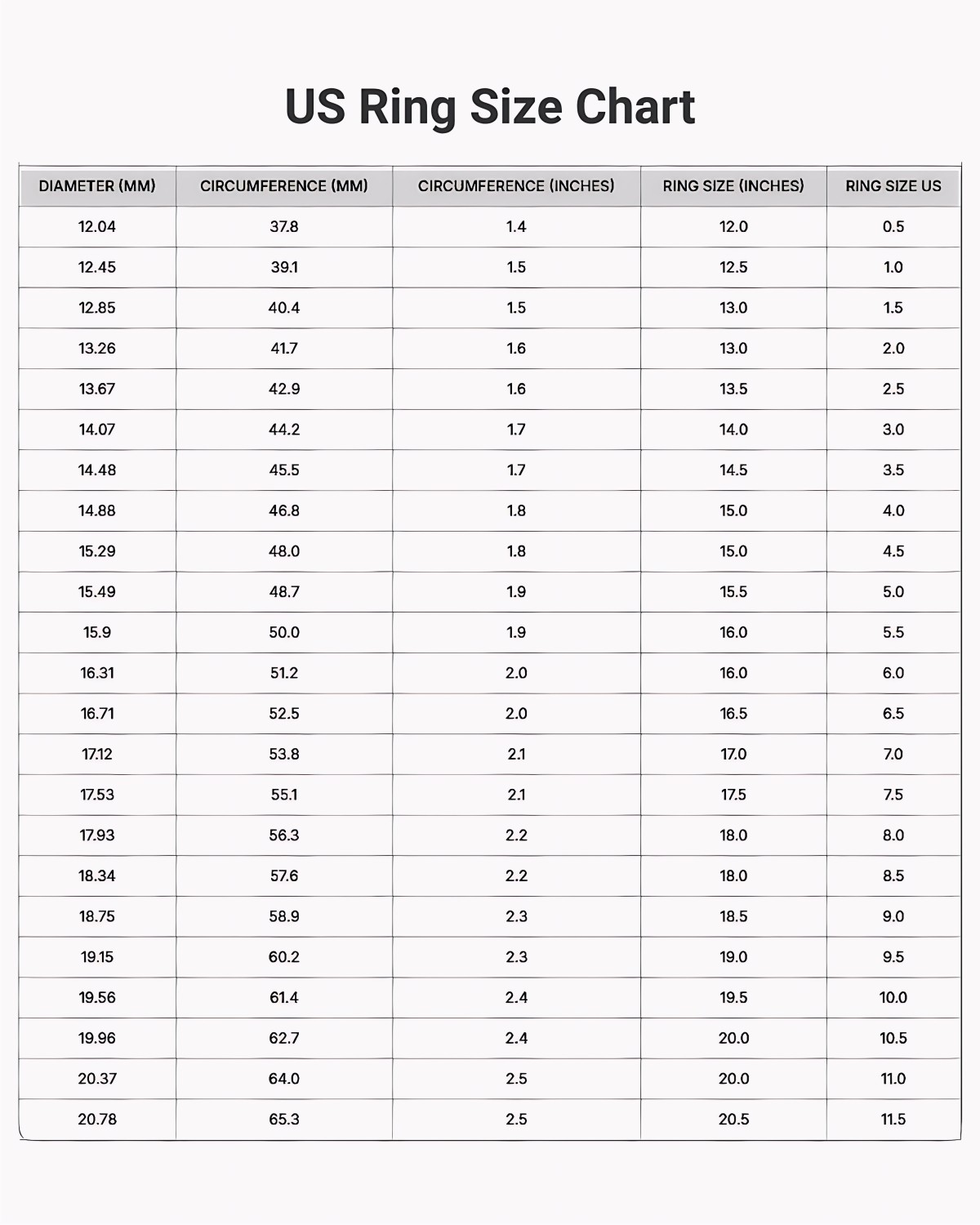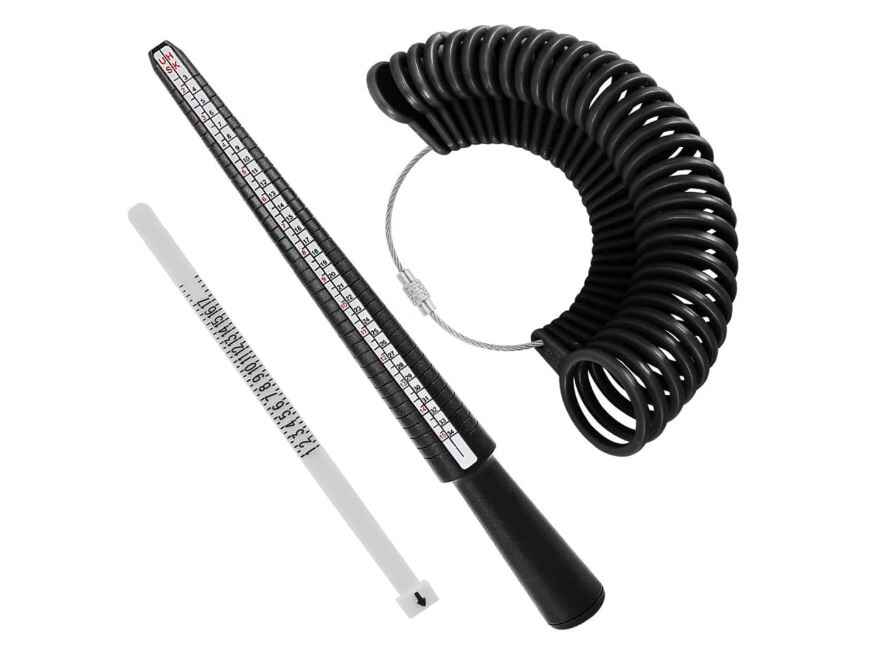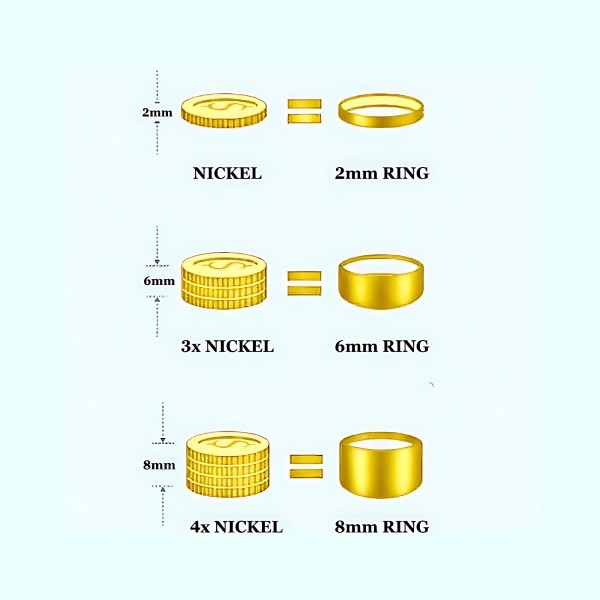Ring Size Guide
Choosing the right ring size is essential for comfort and style. Whether you’re shopping in the US, Europe, Asia, or beyond, this guide will help you understand different sizing systems, compare widths, and find your perfect fit.
1. US Ring Size Chart

Most jewelers in the United States, Canada, and parts of Mexico use the standard US ring sizing system. This method is based on measuring either the inner diameter or the inner circumference of the ring.
Keep in mind that minor variations may occur between jewelers. For example, one jeweler may measure your finger as size 7, while another might size it as 7.5 due to rounding differences.
Tip: To determine your size, measure a ring you already wear or wrap a flexible strip of paper around your finger and compare it to a US size chart.
2. International Ring Size Chart
Ring sizes vary worldwide, and different countries follow unique systems. If you live outside the US, Canada, or Mexico, you can use this conversion information to find your correct size.
- US/CA/MX: Based on inches, commonly used in North America.
- UK/AU/NZ/ZA/IE: Uses letters (A–Z) with half sizes. Each step increases the circumference by 0.75 mm.
- Europe (FR, RU, Scandinavia): Size number equals the inside circumference in millimeters. Example: Size 50 = 50 mm circumference.
- Germany/Argentina: Size number represents the inner diameter in millimeters. Example: Size 18 = 18 mm diameter.
- Brazil: Unique numbering system specific to Brazil.
- Japan/China/Korea/Singapore: Based on diameter, starting at 13 mm. Each size increases by 0.33 mm.
- Switzerland/Spain: Similar to the European system but starts at 40 mm circumference for size 1.
Pro Tip: When ordering internationally, always provide your jeweler with your local size in the “order notes” to ensure an accurate conversion.
3. Ring Sizer Kit

A ring sizer kit is a practical tool for finding your exact size at home. These kits are typically made of plastic or metal loops ranging from small to large sizes. They are especially helpful if you are unsure of your current measurement or if your finger size fluctuates.
Most kits are 4 mm wide, which makes them ideal for comfort-fit rings. Simply slide the ring gauge onto your finger until you find the size that feels snug but comfortable.
4. Band Widths for Men and Women
Ring widths can range anywhere from a delicate 2 mm to a bold 20 mm. The width you choose greatly affects both comfort and style.
Male Hands
There’s no universal “right” width—it’s about what feels and looks best. However, the most popular choices are:
- 8 mm wedding bands (most common)
- 6 mm wedding bands (second most popular)
Female Hands
Women often select slimmer bands, especially to complement engagement rings. Common choices include:
- 4 mm bands (most popular)
- 2 mm bands (ideal if paired with a wider engagement ring)
Note: Balance is key—ensure your engagement ring and wedding band together are not too wide for your finger.
5. Visual Ring Width Guide
When shopping for rings, one of the most common questions is: “How wide will the ring actually look on my finger?” Ring widths are measured in millimeters (mm), which can be hard to picture if you’re used to inches. Below is a simple, practical comparison using everyday objects so you can better visualize common ring widths before you buy.
Quick Tip: If you don’t have a ruler handy, use a U.S. nickel as a reference. A single nickel is about 2 mm thick — perfect for estimating ring width.
How wide is a 2 mm ring?
A 2 mm ring is approximately the same thickness as one U.S. nickel. This is a very slim, delicate band — ideal if you want a subtle, minimalist look or a thin stacking ring. In inches, 2 mm is roughly 0.08 in.
How wide is a 6 mm ring?
A 6 mm ring is about the thickness of three nickels stacked. This width is commonly chosen for men’s wedding bands and for anyone seeking a noticeable but still comfortable band. In inches, 6 mm is about 0.24 in (three × 1/16" nickels ≈ 6/16" ≈ 0.375", but the metric conversion 6 mm ≈ 0.236 in is more precise).
How wide is an 8 mm ring?
An 8 mm ring is roughly the thickness of four nickels stacked. This creates a bold, statement-making look. In inches, 8 mm is approximately 0.31 in (four nickels stacked visually approximate this width).
Quick comparison table
Note: This table compares band width — how wide the ring appears on your finger — not the ring’s diameter or circumference used for sizing.
| Ring Width | Approx. Inches | Everyday Comparison |
|---|---|---|
| 2 mm | ~0.08 in | One U.S. nickel (≈ 2 mm thick) |
| 4 mm | ~0.16 in | Two nickels stacked |
| 6 mm | ~0.24 in | Three nickels stacked |
| 8 mm | ~0.31 in | Four nickels stacked |
Practical tips for choosing width
- Try before you buy: If possible, test different widths on your finger or use a ring sizer to see what feels best.
- Consider finger size: Narrow fingers often suit 2–4 mm bands; medium-to-large fingers commonly pair well with 6–8 mm bands.
- Match with engagement ring: If pairing a wedding band with an engagement ring, make sure combined widths look balanced and comfortable.
- Wider rings feel tighter: Rings wider than ~8 mm can feel snugger, so you may need to go up a half size for comfort.
By comparing ring widths to familiar objects like a nickel, you can quickly picture how a band will look on your hand—making it easier to pick a style you’ll love every day.
6. MM to Inch Conversion Chart
Since ring widths are typically measured in millimeters, the chart below converts common widths into inches for easier visualization. Note: this chart is for band width (how wide the ring appears on your finger), not the ring’s diameter or circumference.
| Millimeters (mm) | Inches | Everyday Comparison |
|---|---|---|
| 2 mm | 0.08 in | About the thickness of a US nickel |
| 4 mm | 0.16 in | About two nickels stacked |
| 6 mm | 0.24 in | About three nickels stacked |
| 8 mm | 0.31 in | About four nickels stacked |
| 10 mm | 0.39 in | Close to the width of a pencil eraser |
| 12 mm | 0.47 in | Roughly half an inch wide |
| 14 mm | 0.55 in | About the width of a AAA battery |
| 16 mm | 0.63 in | Over half an inch wide |
| 18 mm | 0.71 in | Nearly the width of a lipstick tube |
| 20 mm | 0.79 in | Almost ¾ of an inch wide |
7. Comfort Fit vs Standard Fit
In North America, there are two main types of fits: Standard Fit and Comfort Fit.
Comfort Fit
Comfort fit rings are rounded on the inside, making them easier to slide over the knuckle. They cover less skin surface area, reducing friction. This style is especially common for rings made of harder materials like tungsten, titanium, and cobalt chrome. Many jewelers recommend ordering half a size smaller for comfort fit bands.
Standard Fit
Standard fit rings have a flat interior, similar to the inside of a pipe. They are most common in precious metals such as gold, platinum, and palladium. While slightly less ergonomic than comfort fit, they have been a jewelry standard for centuries.
Tip: For rings wider than 8 mm, it’s best not to size down, even with comfort fit, as wider bands naturally feel tighter.
 RingSizeFind
RingSizeFind